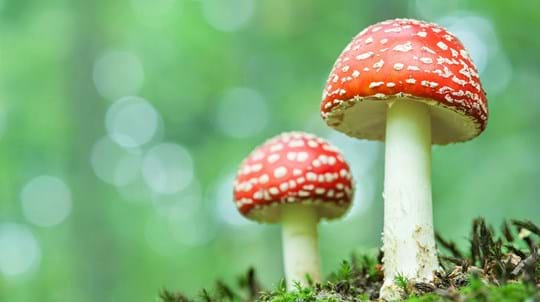
Level up your mushroom identification skills
Our fungi swatch book is full of weird, wacky and wonderfully named fungi. Take a look and see how many you can learn to identify.
Buy a fungi swatch book
Digital Content Manager
Fungi, toadstools, mushies, shrooms – the mushroom kingdom is known by many names, and that’s before you’ve delved deeper into the names of individual mushroom species.
With more than 15,000 different fungi and slime moulds in the UK, we have the pleasure of digging into a rich collection of fascinating, descriptive and, quite frankly, hilarious common and scientific names. From balls, cakes and stinkhorns to discos and piggybacks, let’s take a look at some of the more eyebrow-raising.
Some Victorians were so affronted by stinkhorns that they’d attack them with cudgels to protect impressionable young ladies.
Everything about this mushroom looks and sounds like someone invented it as a practical joke. It’s scientific name literally means ‘shameless phallus’ – Phallus relating to its phallic appearance and impudicus translating to ‘immodest’ or ‘shameless’. It even emerges from a bulbous sack.
If that wasn’t enough, the common stinkhorn smells unmistakably like rotting flesh. This attracts flies, which land on the fungus’s dark tip. This is covered in an olive-green slime called gleba, which sticks to the flies and contains spores which the flies then spread as they go about their day.
Of all the origin stories, this must be one of the best. Hotlips disco was named by 12-year-old Rachael Blackman in a 2011 competition run by Natural England and the Guardian newspaper.
“They looked a bit like lips and I thought the name suited it really well because of the bright orange colour,” Rachael told the Guardian.
You can find hotlips disco puckered up amongst clumps of haircap moss.
Cramp balls make useful fire lighters. Some were discovered alongside other ‘tinder fungi’ during an excavation of a 7,000-year-old Spanish settlement.
Despite the images the name of this fungus might conjure, the cramp that it references isn’t specific to the nether regions. People once believed that carrying cramp balls would protect you from attacks of bodily cramp.
This fungus is also known as King Alfred’s cakes – another name with more innocent origins than it implies. It’s said that King Alfred, on the run from Vikings, took refuge in the home of a peasant woman who asked him to watch over the cakes she was baking. Alas, he let them burn, and scattered the evidence in the woods to allay his embarrassment.
Funny fungi names can come in handy for mushroom identification, especially where poisonous mushrooms are concerned. The yellow stainer gets its name from the fact that it very quickly turns a vivid chrome yellow when handled, though it could just as easily have been named after the ill effects of eating one. Symptoms of yellow stainer poisoning include:
Yellow stainer is often mistaken for the edible field mushroom or horse mushroom, but the speed at which it turns yellow, and the brightness of the yellow stain set it apart.
Slime moulds are classified in a completely different kingdom to fungi, growing on their substrate rather than from it.
When you first set eyes on these pink pustules, wolves probably aren’t the first thing that springs to mind. Yet this is where they get their name, based on the pinky-orange, milky gloop that oozes out when you pop one. Perhaps wolves were once said to drink it? Or maybe somebody crept close enough to a nursing wolf to scrutinise the state of its milk?
We don’t know what a silky piggyback involves, and we aren’t sure we want to find out. What we do know is that it makes for a very descriptive mushroom name. The phor in Asterophora is a form of ‘phero’, meaning ‘to bear’ or ‘carry’ – hence piggyback. The ‘silky’ part comes from the fine hairs on the mushroom’s cap, which give it a silken appearance.
You could also say the name ‘piggyback’ comes from where the mushroom grows – on top of other mushrooms, particularly the charred-looking remains of blackening brittlegill.
This fungus has a parasite with its own funny fungi name: leafy brain fungus. The jelloid mass grows on dead wood that has been attacked by the hairy curtain crust, and feeds on its fungal cousin.
A name that would make your grandmother blush! Thankfully, whoever christened this fungus didn’t have their mind in the gutter. Break down the scientific name and you’ll find that Stereum means ‘tough’ – very apt for crust fungi – and hirsutum means ‘hairy’, which refers to the upper surface of this fungus when it’s young and fresh. The ‘curtain’ part is thought to reflect the rippled edges of the fruiting body, which look like partly drawn curtains.
You’d be forgiven for giggling at this one – do scientists only have one thing on their mind? Vaginata is indeed a form of the Latin word ‘vagina’, but its more literal meaning is ‘sheath’, applied to the grisette because it emerges from a fleshy, sheath-like sack. This sack breaks as the mushroom grows and expands, leaving a cup-like remnant – known as a volva – at the base of the stem.
The wood blewit is known by two scientific names: Clitocybe nuda and Lepista nuda.
At first glance, it looks like the person who gave this mushroom its scientific name knew exactly what they were doing. It still sounds a little suspect even when you dig into the translation: Clitocybe means ‘sloping head’, while nuda means ‘bare’ or ‘naked’.
The wood blewit does look a little like naked skin. When mature, the mushrooms are a beautiful pinky-lilac colour, while younger specimens are a more blue-tinged violet.

Our fungi swatch book is full of weird, wacky and wonderfully named fungi. Take a look and see how many you can learn to identify.
Buy a fungi swatch book
BLOG
Mushrooms (or toadstools) are the fleshy, spore-bearing fruiting bodies that certain fungi produce. Discover 9 common mushrooms you might spot in the woods.

Blog
Hanako Shimada • 19 Feb 2025

Blog
Helen Keating • 29 Oct 2018